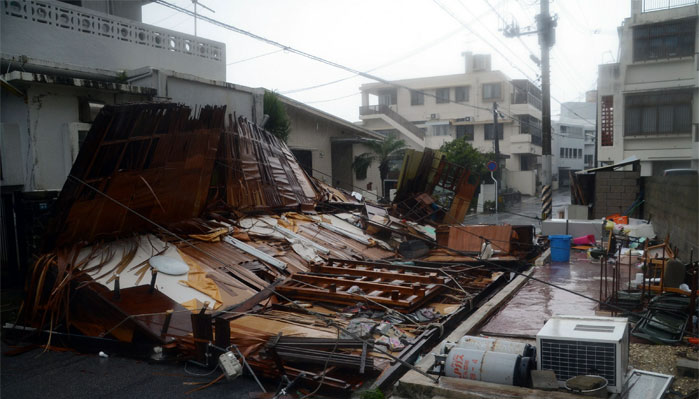A wooden house collapsed during strong winds in Naha on Japan's southern island of Okinawa
AFP/ Okinawa
Powerful typhoon Neoguri lashed Japan's southern Okinawa islands Tuesday, forcing over half a million people to seek shelter, as the region's worst storm in years damaged buildings, downed trees and brought air and sea traffic to a halt.
The typhoon packed gusts of up to 252 kilometres (156 miles) per hour with torrential downpours, forcing the cancellation of hundreds of flights as authorities said at least one person was missing and several were injured by the raging storm.
In the capital Naha, traffic lights went off and television footage showed trees split by the force of the storm, signboards flying around and a restaurant destroyed, with the shattered building blocking a street.
Okinawa police said at least three people were injured, including a 83-year-old woman, with public broadcaster NHK putting the number of injured at eight.
Separately, the coastguard said a 62-year-old man was missing after being knocked off his boat near Japan's mainland, with the weather agency earlier warning that waves could reach as high as 14 metres (45 feet).
Schools across the sprawling archipelago were also closed while nearly 70,000 Okinawan households had no power, NHK said.
Late Monday, the Japan Meteorological Agency issued its highest typhoon alert for Okinawa's main island, home to around 1.2 million people, as well as the outlying Miyako islands.
Authorities warned there was a risk to life, as well as major property damage from the typhoon and subsequent flooding and landslides.
Neoguri comes less than a year after typhoon Haiyan, packing the strongest winds ever recorded on land, killed or left missing more than 7,300 people as it tore across the central Philippines in November.
Japan, a wealthy nation with strict building codes, has a strong track record of coming through major storms comparatively unscathed in the last few decades compared to its poorer neighbours.
Nonetheless Japanese officials are urging people to take the threat posed by Neoguri seriously.
"There are fears about violent winds, high waves and tides and torrential rain that we have never experienced before," Satoshi Ebihara, the Japanese weather agency's chief forecaster, told an evening news conference Monday.
"We are in an abnormal situation where serious danger is imminent," he said.

